Texas wildfires threatened the nation’s primary nuclear weapons facility, the Pantex Plant, prompting urgent action from workers to protect the complex where nuclear weapons are stored and assembled. Despite the fires coming within 3 miles of the facility, officials were confident that the dangerous plutonium pits stored on site would not be impacted by the wildfires. The incident highlighted the risks posed by extreme weather events due to climate change, leading to concerns about the vulnerability of other facilities across the nation that handle radioactive material.
Various laboratories and military facilities, such as Los Alamos National Laboratory in New Mexico and the Santa Susana Field Laboratory in Southern California, face increased risks from extreme weather events. The lessons learned from the Texas wildfires prompted the Department of Energy to require its sites to assess climate change risks and develop plans to address them. Despite these efforts, critics argue that more proactive measures are needed to prepare for future climate risks, especially in the context of licensing decisions and oversight of nuclear facilities.
The Nuclear Regulatory Commission has come under scrutiny for not fully considering potential climate change effects in its decision-making processes for nuclear power plants. A General Accounting Office study recommended that the NRC take future climate projections into account when evaluating risks at nuclear facilities. Climate and energy experts emphasize the importance of anticipating and planning for extreme weather events to protect critical infrastructure and radioactive waste materials from the impacts of climate change.
Plutonium, one of the most dangerous radioactive materials, poses significant health risks if released into the environment. While most plutonium is stored in secure structures designed to withstand fire, incidents like the 2000 Hanford site wildfire highlight the potential threats posed by extreme weather events. The 2018 Woolsey Fire in California raised concerns about the proximity of radioactive contamination to populated areas, prompting cleanup efforts to mitigate future risks.
In addition to wildfires, flooding from intense rainstorms poses a significant risk to DOE sites, affecting operations and forcing shutdowns. Facilities like the Lawrence Livermore National Laboratory in Northern California have experienced evacuations due to wildfires and shutdowns due to flooding. As climate change continues to drive more extreme weather events, DOE sites are investing in infrastructure upgrades to mitigate risks and ensure the safety of radioactive materials and critical operations.
The increased focus on climate change risks at sensitive sites underscores the need for proactive planning and preparation to safeguard against the impacts of extreme weather events. The National Nuclear Security Administration is working to develop methodologies to address climate risks in permitting, licensing, and site-wide assessments. As the threat of climate change intensifies, it is imperative for government agencies and facility operators to prioritize the protection of critical infrastructure and radioactive materials against the growing risks posed by extreme weather.


